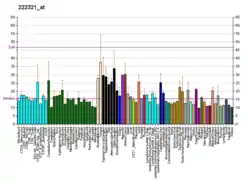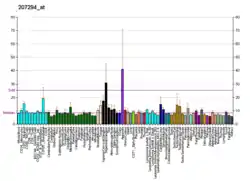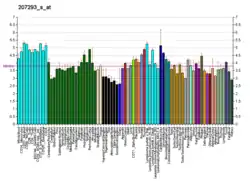Angiotensin II receptor type 2, also known as the AT2 receptor is a protein that in humans is encoded by the AGTR2 gene.[5]
Function
Angiotensin II is a potent pressor hormone and a primary regulator of aldosterone secretion. It is an important effector controlling blood pressure and volume in the cardiovascular system. It acts through at least two types of receptors termed AT1 and AT2. AGTR2 belongs to a family 1 of G protein-coupled receptors. It is an integral membrane protein. It plays a role in the central nervous system and cardiovascular functions that are mediated by the renin–angiotensin system. This receptor mediates programmed cell death (apoptosis). Consistent with its apoptotic function, angiotensin II receptor type II also opposes cell proliferation, as demonstrated by its antagonism of MAPK activity in cardiac fibroblasts during interstitial fibrosis.[6] In adults, it is highly expressed in myometrium with lower levels in adrenal gland and fallopian tube. It is highly expressed in fetal kidney and intestine. The human AGTR2 gene is composed of three exons and spans at least 5 kb. Exons 1 and 2 encode for 5' untranslated mRNA sequence and exon 3 harbors the entire uninterrupted open reading frame.[5]
Stimulation of AT2 by the selective agonist CGP 42112A increases mucosal nitric oxide production.[7]
Gene
Angiotensin II receptor type 2 (AGTR2) gene is a protein coding gene responsible for encoding AGTR2, the integral membrane protein that binds to two different G-protein coupled receptors. AGTR2 has recently been discovered to play a role in modifying lung disease. This receptor functions to mediate signaling in lung fibrosis and regulate nitric oxide synthase expression in pulmonary endothelium. [8] AGTR2 has recently been prescribed as a target for lung inflammation therapy in cases of cystic fibrosis (CF). The X-chromosome region associated with CF lung disease is located in a non-coding region 3′ of the AGTR2 gene. The modification effect is likely due to variation in gene regulation rather than a change in protein coding sequence.
Variants at the X-chromosome locus containing AGTR2 gene were identified as significantly associating with lung function in patients with cystic fibrosis. Genetically modified mouse studies determined that absence of the AGTR2 gene normalized pulmonary function indicators in two independent CF mouse models. Furthermore, pharmacological antagonism of AGTR2 signaling improved lung function in CF mice to near wild-type levels. Manipulation of the angiotensin-signaling pathway to reduce AGTR2 signaling may be translatable for the treatment or prevention of CF.[9]
Interactions
Angiotensin II receptor type 2 has been shown to interact with MTUS1.[10]
See also
References
- 1 2 3 GRCh38: Ensembl release 89: ENSG00000180772 - Ensembl, May 2017
- 1 2 3 GRCm38: Ensembl release 89: ENSMUSG00000068122 - Ensembl, May 2017
- ↑ "Human PubMed Reference:". National Center for Biotechnology Information, U.S. National Library of Medicine.
- ↑ "Mouse PubMed Reference:". National Center for Biotechnology Information, U.S. National Library of Medicine.
- 1 2 "Entrez Gene: AGTR2 angiotensin II receptor, type 2".
- ↑ Tsutsumi Y, Matsubara H, Ohkubo N, Mori Y, Nozawa Y, Murasawa S, et al. (November 1998). "Angiotensin II type 2 receptor is upregulated in human heart with interstitial fibrosis, and cardiac fibroblasts are the major cell type for its expression". Circulation Research. 83 (10): 1035–1046. doi:10.1161/01.RES.83.10.1035. PMID 9815151.
- ↑ Ewert S, Laesser M, Johansson B, Holm M, Aneman A, Fandriks L (March 2003). "The angiotensin II receptor type 2 agonist CGP 42112A stimulates NO production in the porcine jejunal mucosa". BMC Pharmacology. 3: 2. doi:10.1186/1471-2210-3-2. PMC 153509. PMID 12689346.
- ↑ Darrah RJ, Jacono FJ, Joshi N, Mitchell AL, Sattar A, Campanaro CK, et al. (January 2019). "AGTR2 absence or antagonism prevents cystic fibrosis pulmonary manifestations". Journal of Cystic Fibrosis. 18 (1): 127–134. doi:10.1016/j.jcf.2018.05.013. PMC 6830504. PMID 29937318.
- ↑ Corvol H, Blackman SM, Boëlle PY, Gallins PJ, Pace RG, Stonebraker JR, et al. (September 2015). "Genome-wide association meta-analysis identifies five modifier loci of lung disease severity in cystic fibrosis". Nature Communications. 6 (1): 8382. Bibcode:2015NatCo...6.8382C. doi:10.1038/ncomms9382. PMC 4589222. PMID 26417704.
- ↑ Nouet S, Amzallag N, Li JM, Louis S, Seitz I, Cui TX, Alleaume AM, Di Benedetto M, Boden C, Masson M, Strosberg AD, Horiuchi M, Couraud PO, Nahmias C (July 2004). "Trans-inactivation of receptor tyrosine kinases by novel angiotensin II AT2 receptor-interacting protein, ATIP". The Journal of Biological Chemistry. 279 (28): 28989–97. doi:10.1074/jbc.M403880200. PMID 15123706.
- This article incorporates text from the United States National Library of Medicine, which is in the public domain.
Further reading
- de Gasparo M, Catt KJ, Inagami T, Wright JW, Unger T (September 2000). "International union of pharmacology. XXIII. The angiotensin II receptors". Pharmacological Reviews. 52 (3): 415–72. PMID 10977869.
- D'Amore A, Black MJ, Thomas WG (December 2005). "The angiotensin II type 2 receptor causes constitutive growth of cardiomyocytes and does not antagonize angiotensin II type 1 receptor-mediated hypertrophy". Hypertension. 46 (6): 1347–54. doi:10.1161/01.HYP.0000193504.51489.cf. PMID 16286564.
- Regitz-Zagrosek V, Neuss M, Warnecke C, Holzmeister J, Hildebrandt AG, Fleck E (1997). "Subtype 2 and atypical angiotensin receptors in the human heart". Basic Research in Cardiology. 91 (Suppl 2): 73–7. doi:10.1007/bf00795366. PMID 8957548. S2CID 12357519.
- Berry C, Touyz R, Dominiczak AF, Webb RC, Johns DG (December 2001). "Angiotensin receptors: signaling, vascular pathophysiology, and interactions with ceramide". American Journal of Physiology. Heart and Circulatory Physiology. 281 (6): H2337–65. doi:10.1152/ajpheart.2001.281.6.H2337. PMID 11709400. S2CID 41296327.
- Takayanagi R, Ohnaka K, Sakai Y, Nakao R, Yanase T, Haji M, Inagami T, Furuta H, Gou DF, Nakamuta M (March 1992). "Molecular cloning, sequence analysis and expression of a cDNA encoding human type-1 angiotensin II receptor". Biochemical and Biophysical Research Communications. 183 (2): 910–6. doi:10.1016/0006-291X(92)90570-B. PMID 1550596.
- Hein L, Barsh GS, Pratt RE, Dzau VJ, Kobilka BK (October 1995). "Behavioural and cardiovascular effects of disrupting the angiotensin II type-2 receptor in mice". Nature. 377 (6551): 744–7. doi:10.1038/377744a0. PMID 7477266. S2CID 4335142.
- Ichiki T, Labosky PA, Shiota C, Okuyama S, Imagawa Y, Fogo A, Niimura F, Ichikawa I, Hogan BL, Inagami T (October 1995). "Effects on blood pressure and exploratory behaviour of mice lacking angiotensin II type-2 receptor". Nature. 377 (6551): 748–50. Bibcode:1995Natur.377..748I. doi:10.1038/377748a0. PMID 7477267. S2CID 4277560.
- Lazard D, Briend-Sutren MM, Villageois P, Mattei MG, Strosberg AD, Nahmias C (1995). "Molecular characterization and chromosome localization of a human angiotensin II AT2 receptor gene highly expressed in fetal tissues". Receptors & Channels. 2 (4): 271–80. PMID 7719706.
- Martin MM, Elton TS (April 1995). "The sequence and genomic organization of the human type 2 angiotensin II receptor". Biochemical and Biophysical Research Communications. 209 (2): 554–62. doi:10.1006/bbrc.1995.1537. PMID 7733925.
- Chassagne C, Beatty BG, Meloche S (January 1995). "Assignment of the human angiotensin II type 2 receptor gene (AGTR2) to chromosome Xq22-q23 by fluorescence in situ hybridization". Genomics. 25 (2): 601–3. doi:10.1016/0888-7543(95)80072-T. PMID 7790004.
- Koike G, Horiuchi M, Yamada T, Szpirer C, Jacob HJ, Dzau VJ (September 1994). "Human type 2 angiotensin II receptor gene: cloned, mapped to the X chromosome, and its mRNA is expressed in the human lung". Biochemical and Biophysical Research Communications. 203 (3): 1842–50. doi:10.1006/bbrc.1994.2402. PMID 7945336.
- Martin MM, Su B, Elton TS (November 1994). "Molecular cloning of the human angiotensin II type 2 receptor cDNA". Biochemical and Biophysical Research Communications. 205 (1): 645–51. doi:10.1006/bbrc.1994.2714. PMID 7999093.
- Tsuzuki S, Ichiki T, Nakakubo H, Kitami Y, Guo DF, Shirai H, Inagami T (May 1994). "Molecular cloning and expression of the gene encoding human angiotensin II type 2 receptor". Biochemical and Biophysical Research Communications. 200 (3): 1449–54. doi:10.1006/bbrc.1994.1613. PMID 8185599.
- Servant G, Boulay G, Bossé R, Escher E, Guillemette G (May 1993). "Photoaffinity labeling of subtype 2 angiotensin receptor of human myometrium". Molecular Pharmacology. 43 (5): 677–83. PMID 8502225.
- Yamada T, Horiuchi M, Dzau VJ (January 1996). "Angiotensin II type 2 receptor mediates programmed cell death". Proceedings of the National Academy of Sciences of the United States of America. 93 (1): 156–60. Bibcode:1996PNAS...93..156Y. doi:10.1073/pnas.93.1.156. PMC 40197. PMID 8552595.
- Zhang J, Pratt RE (June 1996). "The AT2 receptor selectively associates with Gialpha2 and Gialpha3 in the rat fetus". The Journal of Biological Chemistry. 271 (25): 15026–33. doi:10.1074/jbc.271.25.15026. PMID 8663053.
- Katsuya T, Horiuchi M, Minami S, Koike G, Santoro NF, Hsueh AJ, Dzau VJ (March 1997). "Genomic organization and polymorphism of human angiotensin II type 2 receptor: no evidence for its gene mutation in two families of human premature ovarian failure syndrome". Molecular and Cellular Endocrinology. 127 (2): 221–8. doi:10.1016/S0303-7207(97)04011-2. PMID 9099917. S2CID 39436241.
- Akishita M, Ito M, Lehtonen JY, Daviet L, Dzau VJ, Horiuchi M (January 1999). "Expression of the AT2 receptor developmentally programs extracellular signal-regulated kinase activity and influences fetal vascular growth". The Journal of Clinical Investigation. 103 (1): 63–71. doi:10.1172/JCI5182. PMC 407869. PMID 9884335.
- Lehtonen JY, Daviet L, Nahmias C, Horiuchi M, Dzau VJ (July 1999). "Analysis of functional domains of angiotensin II type 2 receptor involved in apoptosis". Molecular Endocrinology. 13 (7): 1051–60. doi:10.1210/me.13.7.1051. PMID 10406457.
- Knowle D, Ahmed S, Pulakat L (February 2000). "Identification of an interaction between the angiotensin II receptor sub-type AT2 and the ErbB3 receptor, a member of the epidermal growth factor receptor family". Regulatory Peptides. 87 (1–3): 73–82. doi:10.1016/S0167-0115(99)00111-1. PMID 10710290. S2CID 19101120.
- Hansen JL, Servant G, Baranski TJ, Fujita T, Iiri T, Sheikh SP (October 2000). "Functional reconstitution of the angiotensin II type 2 receptor and G(i) activation". Circulation Research. 87 (9): 753–9. doi:10.1161/01.res.87.9.753. PMID 11055978.
External links
- "Angiotensin Receptors: AT2". IUPHAR Database of Receptors and Ion Channels. International Union of Basic and Clinical Pharmacology. Archived from the original on 2016-06-16. Retrieved 2008-11-25.
- Human AGTR2 genome location and AGTR2 gene details page in the UCSC Genome Browser.






